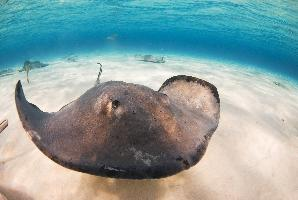
Váhy a míry
| Délka | od 1,5 do 2 m |
|---|---|
| Hmotnost | 130 kg |
Popis zvířete
The Southern stingray, scientifically known as Dasyatis americana, is a captivating marine species that thrives in the warmer waters of the western Atlantic Ocean, including the Caribbean Sea and the Gulf of Mexico. This intriguing creature belongs to the family Dasyatidae, which encompasses various species of stingrays, known for their distinctive flat bodies and long, whip-like tails equipped with one or more venomous stingers.Physical Characteristics:
The Southern stingray exhibits a notably flat, diamond-shaped body that seamlessly blends into its sandy or muddy seabed habitats, making it a master of camouflage. This adaptation is crucial for both predation and protection. The top side of its body varies in color from olive to grey, allowing it to remain inconspicuous against the ocean floor, while the underside is predominantly white, reducing its silhouette from the perspective of predators swimming below. Adult Southern stingrays can reach impressive sizes, with widths spanning up to 5 feet (1.5 meters), although females generally grow larger than males. Their eyes are positioned on the top of their head, providing a wide field of vision to spot potential threats or prey. Meanwhile, their mouth, nostrils, and gill slits are located on the underside, facilitating the consumption of food from the seabed.
Habitat and Distribution:
Preferring shallow, coastal waters, Southern stingrays are commonly found at depths ranging from the intertidal zone to deeper waters, approximately 170 feet (52 meters) below the surface. They are versatile inhabitants of both sandy and muddy seabeds, as well as seagrass beds, which serve as crucial areas for feeding and breeding. Their distribution spans from New Jersey, USA, in the north, all the way to the southern reaches of Brazil, including the serene waters of the Bahamas, the Caribbean islands, and the northern Gulf of Mexico.
Diet and Feeding Habits:
Southern stingrays are benthic feeders, meaning they feed on organisms found on or near the ocean floor. Their diet primarily consists of invertebrates such as worms, mollusks, crustaceans, and occasionally small fish. They employ a unique method of feeding by flapping their wing-like pectoral fins to disturb the sand, uncovering hidden prey. Additionally, they possess specialized mouthparts that allow them to crush and grind their food before ingestion.
Reproduction:
The Southern stingray is ovoviviparous, a reproductive strategy where eggs develop and hatch inside the female's body, and the young are born fully formed. This process allows for a higher survival rate of the offspring, as they are not exposed to the plethora of predators found in the open ocean during their early developmental stages. Females typically give birth to two to ten pups after a gestation period of around four to twelve months.
Conservation Status:
Currently, the Southern stingray is not considered to be at immediate risk of extinction and is classified as "Data Deficient" by the International Union for Conservation of Nature (IUCN). However, like many marine species, it faces threats from habitat destruction, pollution, and bycatch in commercial fishing operations. The beauty and ecological role of the Southern stingray underscore the importance of marine conservation efforts to ensure the health and diversity of ocean ecosystems.
In summary, the Southern stingray is a fascinating and vital component of marine biodiversity in the western Atlantic. Its unique adaptations and behaviors reflect the complexity of life beneath the waves and highlight the interconnectedness of oceanic ecosystems.
Podobná zvířata
Nové fotografie zvířat
Top 10 zvířat
- Dolphin gull (Leucophaeus scoresbii)
- Japanese macaque (Macaca fuscata)
- Stone loach (Barbatula barbatula)
- Greek tortoise (Testudo graeca)
- Galápagos tortoise (Geochelone nigra complex)
- Diana monkey (Cercopithecus diana)
- Russian tortoise (Testudo horsfieldii)
- Moustached guenon (Cercopithecus cephus)
- Galápagos penguin (Spheniscus mendiculus)
- Common flying dragon (Draco volans)
